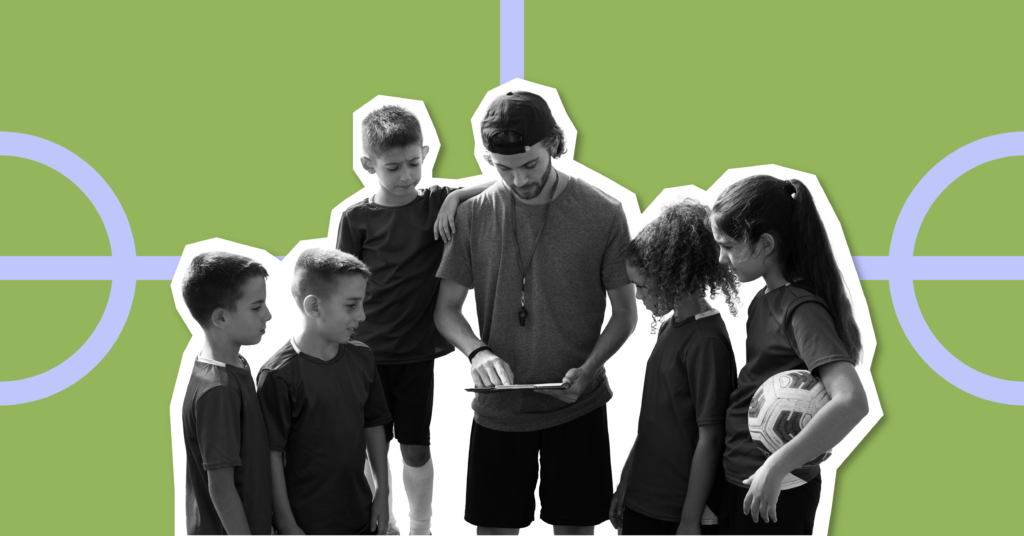No equipment, no problem!
We all know that sinking feeling when you realise you can’t find the PE shed key, or someone has “borrowed” all the footballs. Here are a few ideas for when you’ve got a class ready for PE and absolutely no equipment.
All these activities can be used inside or outside.
Circles
The class sits in a circle, everyone cross-legged with their arms round each other’s shoulders. At a signal, they all try to stand up without breaking hold. This also works well in smaller groups, perhaps building up to the whole class.
Speed Bounce
Children choose a line or a mark on the floor. At a signal, they jump from one side to the other, counting how many bounces they can make before they are told to stop.
Ladders
Put the children in pairs and sit them down in two lines facing each other with legs outstretched, forming a “ladder”. Give each pair a number. When you call their number, the pair must step over the other children’s legs to get to the end of the ladder, run around the ladder and then step over the legs to get back to their places. Make sure there is enough space between the pairs for children to move safely and emphasise the need to move sensibly and to sit sensibly!
Mirror
Put the children into pairs, face to face. Children put their hands out, palms facing but not touching. Partner 1 moves their hand and partner 2 copies, then swap.
Mark your partner
Put the children into pairs. One is the leader; one is the follower. The follower must try to stay close enough to the leader to touch them on the shoulder, without touching them. The children move around the space. When the teacher says “freeze!” the follower checks to see if they can still touch the leader on the shoulder. Then swap roles.
High jump practice
Put the children in pairs, next to a wall. In turns, jump as high as they can, reach up and touch the wall. Ask the children to devise a way of measuring the height jumped (this is easier with a brick wall) One partner jumps 3 times in succession, their partner coaches them, then they swap.
Standing long jump practice
Put the children in pairs and ask them to stand on a line. Partner one jumps as far as they can from the line. Partner 2 stands where Partner 1 landed. Partner 1 returns to the line, takes one step to the side (this is quite important) and jumps again, trying to beat their previous distance.
Slow Race
Line the children up facing forward. Decide on a finish line. The winner is the child who reaches the line last without stopping moving. If a child is seen to stop moving, they are out and must move to the side. They then become a judge, looking out for other people have stopped moving! No bumping or pushing allowed. This is a nice calming cool down activity.
Extensions Ideas
Set the children the challenge of devising a new game or activity in pairs or groups of 4. Explain their game to another pair or group.
The games that I am going to describe can be played with partners, in groups, or as a whole class, with or without gym equipment.
The main skills I want students to demonstrate when they play these games are co-operation, sportsmanship and enjoyment.
1. Catch the Cane
Have the students form a circle or divide the class in two and make two circles. Each student has a number from 1 to the end.
One student is “It” and stands in the middle of the circle holding a cane or meter stick with one end on the floor. This student calls out one of the numbers and let’s go of the cane.
The student whose number was called, must catch the cane before it falls to the floor. If s/he fails, s/he becomes “It”.
2. Overpass
Divide the class into 2 even teams (or 4 for a large class and run two games simultaneously).
Team 1 forms a circle and each member of team 2 stands between two members of team 1.
A team 1 member holds a ball (volleyball, soccer ball, football, etc.) and a member of team 2 holds the same type of ball (differentiate the balls, colour, etc.).
On the word “go”, each team member passes their ball to their team member on their right (or left). The team that completes the full circle with their ball gets a point.
The teacher can vary the game by calling out, “circle” (the student with the ball must run around the circle before passing the ball) or “zig-zag” or “bounce the ball”, etc. I’m sure you get the idea. It’s great fun.
3. Bounce Change
Have students form two lines (the red team and the blue team) behind two leaders about 15 feet apart. Each student in each line gets a number from 1 to the end.
Place a hula hoop at opposite ends of each team’s line. Place a blue ball in one hoop and a red ball in the other hoop.
When the teacher calls out a number, the two students with that number must run to a hoop, get their team’s colour ball and bounce it to the other team’s hoop.
In the meantime, the leader of each team, has their team form and sit in a circle. Once the student place the ball in the other team’s hoop, he returns and sits in his team’s circle. The first team all sitting gets a point.
The game continues with the teacher calling out a different number.
4. Stretched Baseball
Play this game on a baseball diamond or line up 4 bases about 10 feet apart with the first base being about 25 feet from home plate.
Divide the class into two teams, one team at bat and the other in the field. Each player gets a turn at bat instead of 3 outs.
Rather than a baseball, you can use a beach ball or T-ball for primary grade students or kick a soccer ball. If the fielding player throws the ball past home plate before the runner reaches home, the runner is out.
Count runs just as in baseball.
5. The Oyster Shell
Divide the class into two teams (“X” and “Y”) and have them stand along two parallel lines with a space of 10 feet between the lines. This space is neutral territory.
Each team has a goal line some distance back from their parallel line.
The teacher, standing in the neutral area, tosses the oyster shell (use a bean bag with a taped “X” on one side and “Y” on the other) into the air. If it lands with the “X” side up, the “X” team members must run back to their goal line before a “Y” team member tags (captures) them.
The “Y” team scores a point for each “X” team member captured. The first team to reach a certain score or with the most points after a certain time win.
6. Treasure Chase
Students line up behind a line with hands folded so that there is a small opening at the top of their hands.
One student faces the line with a small treasure (stone, piece of chalk, etc.) in his folded hands.
The student with the treasure starts at either end of the line and puts his hands over each student’s hands as if to drop the treasure into them.
One student does get the treasure and waits until he thinks no one is watching him. At that point he runs toward a goal line at the far end of the gym or field.
If he reaches the goal line without being tagged hew wins. If he’s tagged, the tagger gives out the treasure for the next game.
7. The Mouse Trap
Half of the class join hands and form a large circle.
The other half of the class are mice and run in and out of the circle.
On a signal from the teacher, the trap closes (students drop arms and squat).
All mice caught in the trap are out. Repeat until all the mice are caught and then switch the mice and the students forming the trap.
This website has some brilliant lesson plans and activities for you to bookmark and explore further.
Check out our relevant courses

Health and PE Activities and Games
This course will assist you in creating and sourcing excellent HPE resources, teaching engaging lessons with minimal preparation, and building your knowledge in the HPE subject area.

Creating a Highly Effective Relief Teacher Bag of Tricks
Presented by Mel Lichnovsky-Klock; learn how to create and curate a highly effective ‘bag of tricks’ for those occasions when you need something that is engaging and can be implemented easily.



